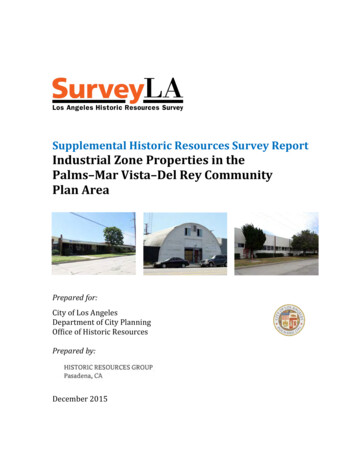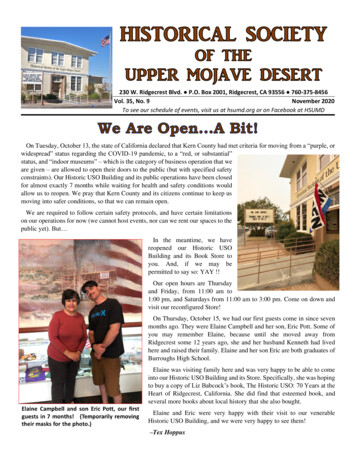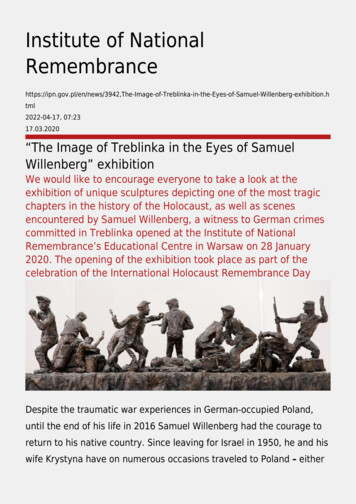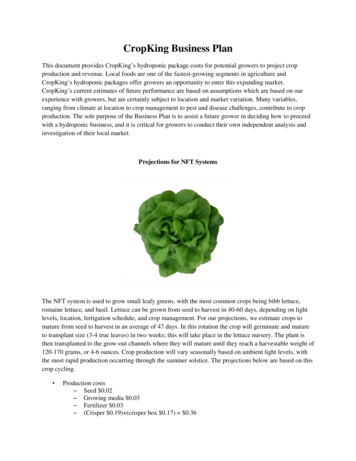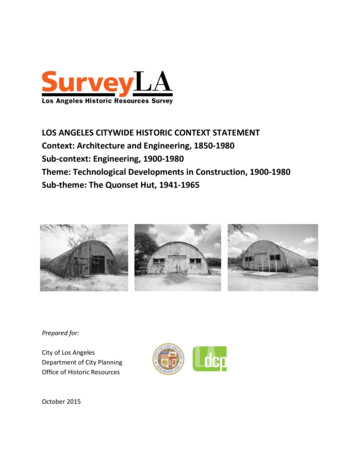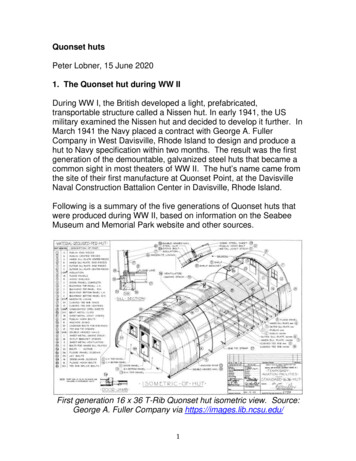
Transcription
Quonset hutsPeter Lobner, 15 June 20201. The Quonset hut during WW IIDuring WW I, the British developed a light, prefabricated,transportable structure called a Nissen hut. In early 1941, the USmilitary examined the Nissen hut and decided to develop it further. InMarch 1941 the Navy placed a contract with George A. FullerCompany in West Davisville, Rhode Island to design and produce ahut to Navy specification within two months. The result was the firstgeneration of the demountable, galvanized steel huts that became acommon sight in most theaters of WW II. The hut’s name came fromthe site of their first manufacture at Quonset Point, at the DavisvilleNaval Construction Battalion Center in Davisville, Rhode Island.Following is a summary of the five generations of Quonset huts thatwere produced during WW II, based on information on the SeabeeMuseum and Memorial Park website and other sources.First generation 16 x 36 T-Rib Quonset hut isometric view. Source:George A. Fuller Company via https://images.lib.ncsu.edu/1
Original T-Rib Quonset hut: Fuller’s first design was semi-circular,16 feet wide by 36 feet long (576 ft2), and constructed of heavy 1-inchthick T-shaped low-grade (non-strategic) steel and angle iron archesand covered in corrugated steel panels. Each Quonset hut usedabout four tons of steel. The two ends of the huts were finished inplywood, and included doors and windows. Known as the "T-Rib”Hut," it shipped in 10 crates and could be erected in one day by acrew of 8 to 10 persons. In June 1941, the Navy made its firstshipment of Quonset huts overseas.Quonset Re-design: Fuller’s second-generation of the T-Rib Hut,with a 4-foot high vertical sidewall (knee wall), followed the originalversion on the production lines. After a production run of severalthousand units, production of the T-Rib Huts was halted sometime in1942.Second generation 16 x 36 T-Rib Quonset hut with knee wall,isometric view. Source: George A. Fuller Company, adapted fromVarnum Continentals, 2016Stran-Steel Quonset hut: Production continued with the thirdgeneration hut, in which the T-rib was replaced with the lighter StranSteel framing system that required little more than a hammer andnails to set it up. A crew of just six people could erect a hut in a single2
day. This hut was larger, at 20 feet by 48 feet (960 ft2), and used 31 2 tons of steel, a half-ton less than the T-Rib Huts. The arch-ribwas semi-circular with a 4-foot knee wall.The Stran-Steel metal framing system, developed in the 1930s byGreat Lakes Steel Corporation, Detroit, MI, was designed to preciselyreplace wood studs, joists, rafters, and sill plates in commercial andresidential construction. The key to this framing system was itslightweight structural I-beam that was formed by welding two rolledsteel channels back-to-back. A nailing grove in the curved spacebetween the channels deformed the nails and held them in place byfriction. Use of double-headed nails enabled the nails to be removedlater with minimal damage to the structure.Stran-Steel for permanent construction with single-headed nails (left)and for demountable Quonset hut construction with double-headednails (right). Sources: Stran-Steel Corporation via the Internet Archive(left), and Chiel & Decker, “Quonset Hut: Metal Living for a ModernAge” (right)4th-generation: In the later fourth design, which was manufacturedby Stran-Steel, the Navy eliminated the knee wall and returned to afull semi-circular design; 20 by 48 feet in size. This change simplified3
manufacturing and erection, and significantly reduced the shippingvolume per hut. These huts were designed with and without dormerwindows.5th-generation: The fifth design retained the full semi-circular designand size (20 by 48 feet), but used flat corrugated siding mountedhorizontally for the sides while retaining the curved plates for the roofridge. This arrangement reduced the need for special manufacturingof curved corrugated siding panels. Dormer windows were replacedby either translucent corrugated panels or flat steel framed windows.Toward the end of 1943, 4-foot overhangs were added to theQuonset hut to prevent driving rains and sunlight from entering thehuts. These huts had the same floor space and measured 20 by 56feet, including the overhang. As finally developed, Quonset hutsrequired less shipping space than did tents with wood floors andframes, when equal numbers of people were to be accommodated.Various other versions of metal arch buildings that resembledQuonset huts were used in WW II, including some large unitsmeasuring 40 x 100 and 40 x 160 feet that were developed for use asbarracks and warehouse.Between 150,000 and 170,000 Quonset huts of all models weremanufactured during World War II.2. Post-war re-purposed Quonset hutsAfter the war, many thousands of surplus Quonset huts and other warsurplus housing units were acquired by municipalities for use astemporary, stop gap, public housing, primarily for returning veteransand their families. Typically, each 20 x 48 foot Quonset hut waserected on a concrete slab floor and partitioned into two 20 x 24 foot(480 ft2) apartments, each consisting of a living / dining room, twobedrooms, a bathroom, and a kitchen.In addition, many colleges and universities, struggling withburgeoning post-war enrollment by veterans funded by the GI Bill,acquired Quonset huts and other war surplus housing units fordormitory-style student housing and staff apartment housing.4
In this article, we’ll take a look at the following examples of surplusQuonset hut use in the immediate post-war period. Brooklyn, NY post-WW II veteran’s temporary housing Roger Young Village, Los Angeles veteran’s temporary housing Michigan State University (MSU) post-war temporary studenthousing Colorado State University (CSU) Quonset Village temporarystudent housingAn idealized 1946 view of a surplus Quonset hut village.Source: Popular Science Monthly, March 19465
Many of the post-war temporary housing projects lasted longer thanoriginally expected. In November 1949, the federal governmentproposed to demolish all of the temporary housing projects. By themid-1950s, many had been closed down, including the two examplesin Brooklyn, NY and Los Angeles, CA. The Quonset huts had servedtheir purpose as stopgap housing and were replaced by various typesof permanent conventionally constructed housing units.Brooklyn, NY post-WW II veteran’s temporary housingTo help ease the post-WW II housing shortage, New York City’s“master builder,” Robert Moses, who was then responsible for thecity’s public housing projects, proposed erecting Quonset huts onvacant land in Brooklyn and Queens. After heated public debate,NYC agreed to use 500 surplus Quonset huts as temporary housing.Sites were agreed on acres of land on Long Island: Canarsie, Jamaica Bay and the area along the Belt Parkway inthe south of Brooklyn Jackson Heights, Middle Village and Corona in Queens.A row of Quonset huts with overhangs in Canarsie. Brooklyn, NY.Source: Brooklyn Public Library via 6sqft.com, 21 April 20176
The Quonset huts were used as housing units until about the mid-50swhen more permanent housing became available. The Quonset hutswere taken down and sold to the public for a variety of uses.You’ll find more information on Quonset hut villages in Brooklyn andQueens at the following links: Dana Schultz, “The history of NYC’s Quonset Huts, RobertMoses-era veterans housing,” 6sqft, 21 April nset-huts-robertmoses-era-veterans-housing/ “Brooklyn Housing Shortage (1946),” The BrownstoneDetectives, 27 March klyn-housingshortage-1946/Roger Young Village, Los Angeles veteran’s temporary housingThree months after the end of WW II, the Federal Public HousingAuthority announced in December 1945 that Los Angeles was eligibleto receive surplus military dwellings, such as Quonset huts andbarracks, along with funds to convert them to temporary domesticuse. One of the products of this announcement was Rodger YoungVillage, a public housing project built in Los Angeles by the city’sHousing Authority to provide temporary housing for veteransreturning to the Southern California area after World War II.Built in about two months during the spring of 1946 on a 160-acretract of city land in Griffith Park, on the former site of Griffith ParkAerodrome, the Village consisted of 750 late-model Quonset huts thatwere moved from the naval facility in nearby Port Hueneme. Thecost to tear down, move and reassemble each Quonset hut wasestimated at 1,800. Each Quonset hut was partitioned into separateduplex apartments, providing housing for 1,500 families, over 5,000persons. The Village was dedicated on 27 April 1946. More than13,000 veterans applied for the 1,500 available housing units.7
Griffith Park Aerodrome in 1937. This became the site Roger YoungVillage. Source: aerofiles.com via valley Relics MuseumRoger Young Village after completion. Source: White’s Studio viaLos Angeles Public Library, Photo Friends8
Quonset hut construction at Rodger Young Village. Source: Photo byLouis C. Stoumen, Housing Authority of the City of LAElectrician connecting wires to Quonset hut homes. Source: HousingAuthority Collection, photo by Louis Clyde Stoumen, circa 19509
A mature Quonset hut neighborhood. Source: Housing AuthorityCollection, photo by Leonard Nadel, 19 July 1950.When the federal government proposed in 1949 to demolish all of itspostwar “temporary” emergency housing projects, Los Angelesrequested and was granted relief because it had and ongoingshortage of affordable housing. In January 1952, the LA CityRecreation and Park Commission refused to renew the city’s HousingAuthority’s lease on the Rodger Young property, claiming that the“emergency housing shortage no longer exists.” The city also hadother development plans for that tract of land.Rodger Young Village was closed in 1954, and today, no traceremains. The site is now home to part of the Griffith Park Zoo andnearby freeway interchanges.10
You’ll find more information on Rodger Young Village at the followinglinks: J. H. Graham, “Home Sweet Hut: Rodger Young Village,”25September 2017: er-young-village/ Annie Murphy, “The Small Town in a Big City – Life at RodgerYoung Village, Los Angeles Public Library, Photo Friends, 18January 2017: y-life-at-rodger-young-village/Michigan State University (MSU) temporary student housingAn 9 September 2016 article posted on the MSU archives reports:“After the end of World War II, soldiers returning home were lookingto continue on with their lives, by either returning to work, gettingmarried and starting a family, or attending school. Now that returningsoldiers had access to funding from the G.I. Bill there was onehuge problem: where to put the influx of students?. In 1946, thepopulation of the campus doubled in size. Campus went from 7,500to 15,000 students.”Part of the solution was 104 Quonset Huts, which were used to house1,456 single men. In addition, a variety of other war surplus housingunits were acquired and spread across the campus to meet studenthousing needs. While the Quonset Huts were intended for temporaryuse, some stood until the late 1980s.For more information on post-WW II temporary student housing atMSU, see the article, “History of Temporary Housing on Campus afterWWII,” at the following 1
Aerial View of the MSU campus showing the TemporaryHousing Area in 1946. Source: Archives@MSUMSU Quonset Hut Village, 1946. Source: Archives@MSU12
Colorado State University (CSU) Quonset Village studenthousingAt CSU (then Colorado A&M), in Ft. Collins, CO, the number ofenrolled veterans increased 435% during the 1945 - 46 academicyear. To meet the demand for student housing, the universityestablished a Veteran’s Village created with a combination of warsurplus Quonset huts, trailers and prefabricated houses.By 1961, most of the Quonset huts from Veteran's Village had beenremoved to make way for permanent residential halls. CSU offeredthe old Veteran's Village huts for sale to the general public.CSU post-WW II Veterans Village.Source: The Coloradoan, June 201913
CSU Quonset hut.Source: The Coloradoan, June 2019For more information on the CSU Veterans Village, see the followingonline resources: Adam Thomas, “Soldiers of the Sword, Soldiers of thePloughshare - Quonset Huts in the Fort Collins Urban GrowthArea - Historical Context and Survey Report,” Historitecture,LLC, July 2003:http://www.historitecture.com/pdf/quonset huts.pdf Erin Udell, “What ever happened to the huts at Colorado StateUniversity's Veteran's Village?” The Coloradoan, 21 June set-huts-fort-collinshistory/1490954001/14
3. Relevance of Quonset huts todayMany durable post-war Quonset huts survive today in the US and arein use as outbuildings, museums, businesses, homes and garages.The basic metal arch design element of the Quonset hut has evolvedinto a range of modern metal arch structures. Several firms supplyprefabricated steel arch structures for commercial or residential use.Like the WW II Quonset huts, modern steel arch structures have areputation for durability, strength, and ease of construction. Many ofthese are quite utilitarian, while some have strong, modernarchitectural content. A few examples are shown below, including amulti-family Quonset hut development that bears more than a passingresemblance to the idealized view of a Quonset hut village in theMarch 1946 issue of Popular Science Monthly magazine.Berkshire Bird Paradise Sanctuary and Botanical ind-blowing-quonsethut-builders-will-inspire/15
Two arched structures comprise the “G Home” in Henderson, NV.Source: dhouse-in-nevada/33’ x 44’ prefabricated steel arch residence in Joplin, Missouri.Source: mesafe-easy-affordable/16
Edwin Chan teamed up with developer Philip Kafka and his realestate company, Prince Concepts, to create a unique multi-familysteel Quonset hut development known as True North Detroit. Thissmall development is comprised of eight prefabricated modernQuonset huts, several of which are designed as live/work spaces.True North Detroit was one of the winners of the 2017 ArchitectsNewspaper’s Best of Design Award and one of six finalists for theMies Crown Hall America’s Prize.Modern Quonset hut multi-family development True North Detroit.Eight different style Quonset huts in True North Detroit. Source, bothgraphics: http://www.princeconcepts.com/true-north-detroit17
A second Prince Concepts modern Quonset hut development inDetroit is known as The Caterpillar, which will have six residentialunits and two live/work units in one large 46’ x 192’ SteelMaster QModel hut with 8,700 ft2 of floor space.Prince Concepts’ The Caterpillar during construction. pillar-detroitPrince Concepts’ The Caterpillar floor plan. pillar-detroit18
4. For more information, see the following resources:Quonset hut wartime history: “Quonset Hut,” Naval History and Heritage Command, 9 tions/quonset-hut.html “Quonset Huts,” Seabee Museum and Memorial Park, RhodeIsland: https://www.seabeesmuseum.com/visit/quonset-huts Brian Wallin, “The Quonset Hut: A Rhode Island Original ThatWent to War – Worldwide,” Varnum Continentals, 10 April2016: hut-arhode-island-original/ “US Navy Quonset Hut: Origin of Design,” quonsethut.blogspot, 10 December 2012: nset-hut-origin-ofdesign.html “Quonset Huts – The History of Metal Arch Buildings ThatAccompanied the WW II Shelter Needs,” PowerBilt SteelBuildings, Inc.: wwii-shelter-needs “Quonset Hut: Improvements and Modifications,” The Castrumand the Quonset Hut, 19 January /quonset-hutimprovements-and.html “Stran-Steel Construction Data,” Stran-Steel Division, GreatLakes Steel Corporation, Detroit, MI, atLakesSteelCorporation/page/n15/mode/2up Digital copies of manuals for several models of Quonset hutsare available on the Seabee Museum website at the m/Publications/quonset-hutmanuals0.html19
Quonset huts and their use as stop gap housing after WW II: Hartley E. Howe, “Stop Gap Housing – Millions of FamiliesCan’t Wait for Permanent Homes,” Popular Science Monthly,Vol. 148, No. 3, pp. 66 – 71, March 1946:https://books.google.com/books?id PSEDAAAAMBAJ&printsec frontcover&source gbs ge summary r&cad 0#v onepage&q&f false Michael Lamm, “The Instant Building - Simple to manufactureand easy to assemble, the Quonset hut outlasted the war forwhich it was built,” Invention & Technology, Winter ant-building-1Relevance of the Quonset hut today: Chris Chiel and Julie Decker, “Quonset Hut: Metal Living for aModern Age,” Princeton Architectural Press, New York, NY, 31December 2005, ISBN-13: 978-1568985190 Henry Parker, “Quonset Hut Homes: The Definitive es/ H. Bosler, “Quonset Hut: A Modern Dwelling,” Mid-CenturyModern Groovy:https://www.midcenturymoderngroovy.com/?p 8259 “True North: Detroit,” Prince detroit “The Story Behind Detroit’s Quonset Hut Community ‘TrueNorth’”, th-detroit/ “Detroit Quonset Hut Village Wins 2017 Best of Design Award,”Steelmaster Building t-quonset-hutvillage-wins-2017-best-design-award/ “The Caterpillar: Detroit,” Prince erpillar-detroit20
cost to tear down, move and reassemble each Quonset hut was estimated at 1,800. Each Quonset hut was partitioned into separate duplex apartments, providing housing for 1,500 families, over 5,000 persons. The Village was dedicated on 27 April 1946. More than 13,00
